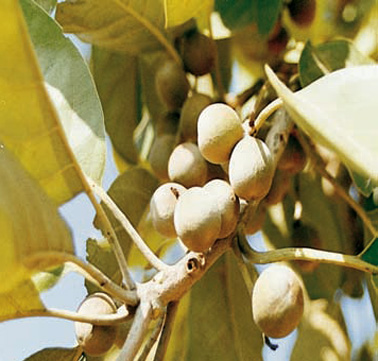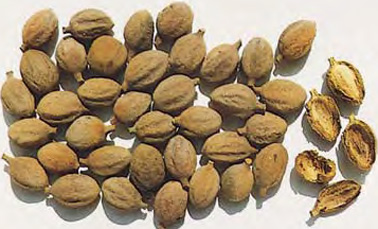|
Botanical Name:
Terminalia belerica
Bibhitaki consists of pericarp of dried ripe fruits of
Terminalia belerica Roxb, Family Combretaceae
Common Name(s) in English & Indian Languages
Sanskrit: Vibhita, Aksa, Aksaka
Assamese: Bhomora, Bhomra, Bhaira
Bengali: Bayada, Baheda
English: Beleric Myrobalan
Guajarati: Bahedan
Hindi: Bahera
Kannada: Tare kai, Shanti Kayi
Kashmiri: Babelo, Balali
Malayalam: Tannikka
Marathi: Baheda
Oriya: Baheda
Punjabi: Bahera
Tamil: Thanrikkai
Telugu: Thanikkaya
Urdu: Bahera
Botanical description:
A large deciduous tree 10-12 m or more high, with straight &
tail trunk. Leaves sub opposite, hairy, 6-18 cm long, ovate
or oblong ovate, elliptic, clustered at the end of the
branch lets, acuminate, lateral nerves prominent. Petiole
1-2.5cm long, usually with glands on the upper side. Flower
greenish white or yellow 0.2 – 0.25” in diameter in solitary
axilliary or extra axilliary spikes, 3-6” long, sessile,
bisexual, bracts longer than the flower buds. Calyx lobes 5,
short, triangular, limb cup-shaped. Stamen -10. Fruits are
dark brown to black tomentose, subglobose or pyriform
showing only faint furrows when dry. Taste in astringent,
1.3-2cm in length, obscurely 5 angled. Wood is yellowish.
The furits are pulpy with hard & strony seeds.
Parts used:
Fruits
Major chemical constituents:
Gallic acid, tannic acid and glycosides.
Therapeutic uses:
• Emesis (Chardi)
• Cough (Kasa)
• Worm infestation (Krmiroga)
• Constipation (Vibandha)
• Hoarseness of voice (Svarabheda)
• Disease of eyes (Netraroga) |
|


|
|
|



